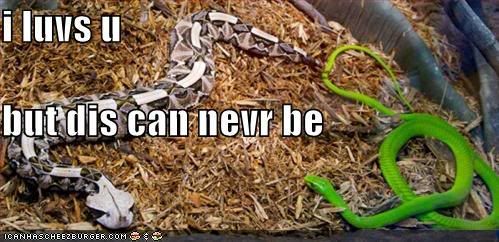I am probably going to regret being involved in this discussion.....
But the last couple of days I have been thinking a lot about the cultural differences and it's kind of interesting IMO.
In my country I have never seen such strong emotions regarding cohabbing, in fact, I'm pretty shocked that this is such a "religious" matter here. Even though most people won't exactly recommend it, you are not at risk of getting accused of cruelty or anything like that.
Also I don't hear nearly as many horror stories about it.
I have been wondering about if it could have something to do with stress level besides from the cohabbing. In my country we generally don't handle our snakes nearly as much as you guys do - and in contrast to cohabbing, extensive handling is something that can cause people to get very angry with you. And I agree. IMO handling is usually stressful for the snake and the owner does it solely for his/hers own pleasure, cause the snake will rather be left alone. A lot of people only handle their snakes when they feed them and if they are fed in the viv, not even then. Note that I am not judging anyone!
But I have been thinking that you might see more problems with cohabbing because you have more stress factors for the snakes in daily life in general.
I am not advocating cohabbing - and if I should get two more snakes (but I'm not) then I probably wouldn't do it. But at the same time I'm pragmatic. If you use your eyes wisely and is observant and react to changes, I really think the risk is very minor. And if you snakes shows no signs of stress whatsoever and are functioning perfectly, then chances are that they are perfectly fine. Not saying that there aren't disadvantages to cohabbing anyway and you have to use your head, if you chose to do it anyway.
I have never heard of a single documented case where one adult corn snake has eaten another - babies are, of course, another matter.
But the last couple of days I have been thinking a lot about the cultural differences and it's kind of interesting IMO.
In my country I have never seen such strong emotions regarding cohabbing, in fact, I'm pretty shocked that this is such a "religious" matter here. Even though most people won't exactly recommend it, you are not at risk of getting accused of cruelty or anything like that.
Also I don't hear nearly as many horror stories about it.
I have been wondering about if it could have something to do with stress level besides from the cohabbing. In my country we generally don't handle our snakes nearly as much as you guys do - and in contrast to cohabbing, extensive handling is something that can cause people to get very angry with you. And I agree. IMO handling is usually stressful for the snake and the owner does it solely for his/hers own pleasure, cause the snake will rather be left alone. A lot of people only handle their snakes when they feed them and if they are fed in the viv, not even then. Note that I am not judging anyone!
But I have been thinking that you might see more problems with cohabbing because you have more stress factors for the snakes in daily life in general.
I am not advocating cohabbing - and if I should get two more snakes (but I'm not) then I probably wouldn't do it. But at the same time I'm pragmatic. If you use your eyes wisely and is observant and react to changes, I really think the risk is very minor. And if you snakes shows no signs of stress whatsoever and are functioning perfectly, then chances are that they are perfectly fine. Not saying that there aren't disadvantages to cohabbing anyway and you have to use your head, if you chose to do it anyway.
I have never heard of a single documented case where one adult corn snake has eaten another - babies are, of course, another matter.

